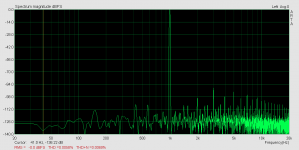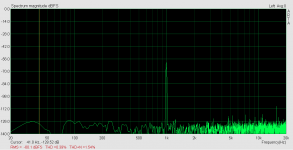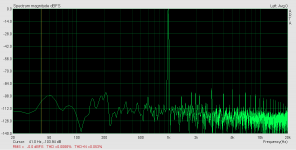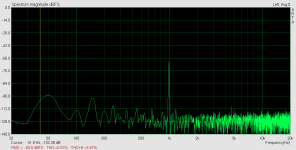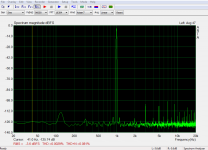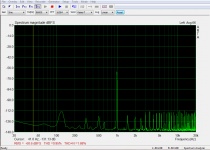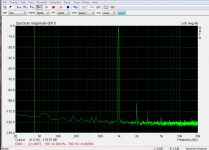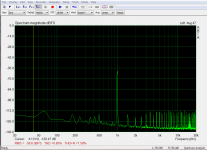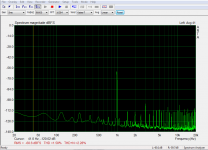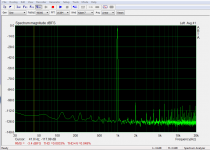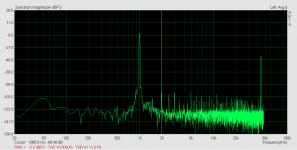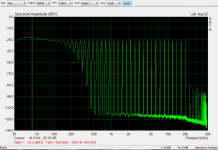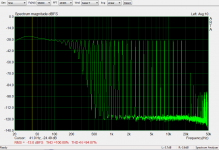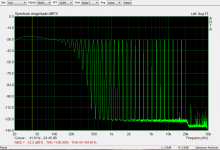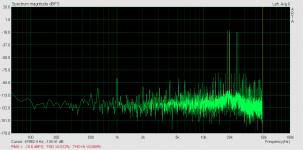I have a new "toy" E-MU 1820 (with PCM1804 ADC) do I decided to do some THD testing of my digital players. Thought to share the results here. I don't know how accurate are ARTA calculations, so I will post the screen-grubs too. The table is my attempt to centralize and interpret the data. Actual resolution is calculated from THD+N results (provided by ARTA).
A quick note - I did those measurements with unbalanced cables, in "consumer" mode (because my players have unballanced outs). That is at -10dB level compared with than the ballanced "professional" mode that can go to +4dB... The loopback was done the same way, I will get a ballanced cable and redo that measurement soon.
LE: Updated table with the 1820m version that has better A/D converter (AK5394A). Updated pictures are in posts #22,23,24:

PCM61 & LM4562 (modded Denon DCM-360) - sorry, I didn't realized that the bottom level was shifted (it doesn't matter in calculations):
TDA1541 & LM4562 (modded Philips CD-473):
PCM1791 & AD8599 (modded Denon DVD-2910):
2x PCM1791 & NJM2068 (Denon DVD-2930CI, stereo out):
CS4392 & NJM2068 (E-MU 1820 output):
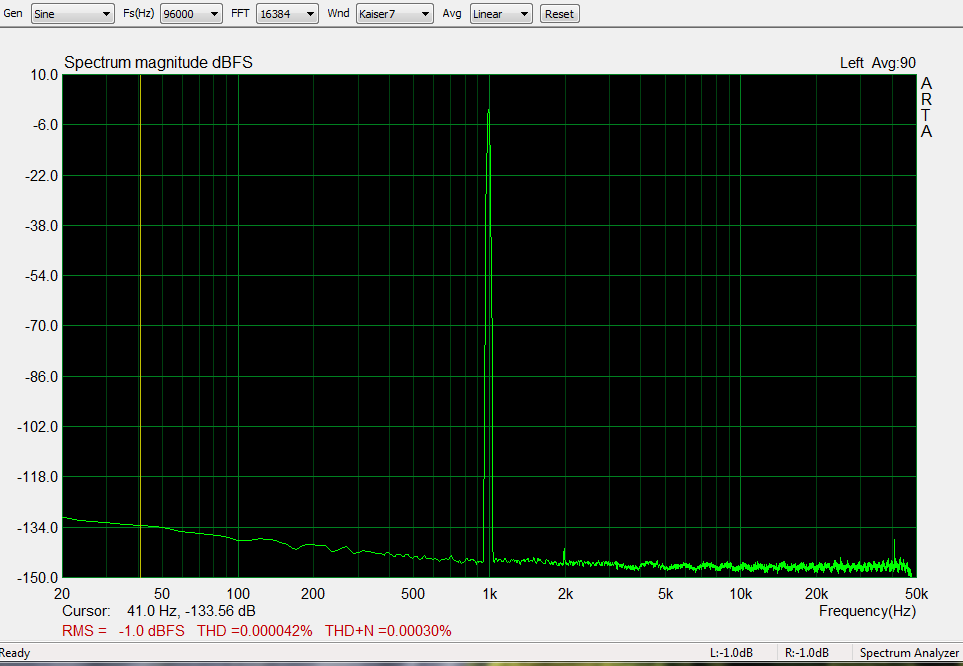
UPDATE: I did upgrade my external dock to the E-MU 1820m (with AKM AK5394):
A quick note - I did those measurements with unbalanced cables, in "consumer" mode (because my players have unballanced outs). That is at -10dB level compared with than the ballanced "professional" mode that can go to +4dB... The loopback was done the same way, I will get a ballanced cable and redo that measurement soon.
LE: Updated table with the 1820m version that has better A/D converter (AK5394A). Updated pictures are in posts #22,23,24:

PCM61 & LM4562 (modded Denon DCM-360) - sorry, I didn't realized that the bottom level was shifted (it doesn't matter in calculations):
An externally hosted image should be here but it was not working when we last tested it.
An externally hosted image should be here but it was not working when we last tested it.
TDA1541 & LM4562 (modded Philips CD-473):
An externally hosted image should be here but it was not working when we last tested it.
An externally hosted image should be here but it was not working when we last tested it.
PCM1791 & AD8599 (modded Denon DVD-2910):
An externally hosted image should be here but it was not working when we last tested it.
An externally hosted image should be here but it was not working when we last tested it.
2x PCM1791 & NJM2068 (Denon DVD-2930CI, stereo out):
An externally hosted image should be here but it was not working when we last tested it.
An externally hosted image should be here but it was not working when we last tested it.
CS4392 & NJM2068 (E-MU 1820 output):

UPDATE: I did upgrade my external dock to the E-MU 1820m (with AKM AK5394):
An externally hosted image should be here but it was not working when we last tested it.
Last edited:
Hi,
Looking at loop-back results and the results for the AD alone, something is grievously wrong in your set-up. So your measurements of external gear are likely pointless.
Could be bad cables, problems with level settings etc, I don't know.
I have several EMU1616m in use for measurements, who share the ADC and circuit of your 1820, AFAIK, I get nearly 120dB SNR in loopback, including DIY breakout box, cables from breakout box to EMU and the cables used in the setup, with their ends connected by an adapter.
Cables are double screened starquad mike cable (tinned) for Breakout Box to EMU and Foil & Braid screened 75R Coax externally with BNC's and BNC to RCA adapters at the end (all connectors NOT goldplated).
I use precisely the same cables on the AP2 that is a few meters away.
Maybe crucial, the DUT is fed floating earth balanced power, as is the PC connected to the EMU (separate transformers) and the same set-up applies to the AP2...
Ciao T
I have a new "toy" E-MU 1820 (with PCM1804 ADC) do I decided to do some THD testing of my digital players.
Looking at loop-back results and the results for the AD alone, something is grievously wrong in your set-up. So your measurements of external gear are likely pointless.
Could be bad cables, problems with level settings etc, I don't know.
I have several EMU1616m in use for measurements, who share the ADC and circuit of your 1820, AFAIK, I get nearly 120dB SNR in loopback, including DIY breakout box, cables from breakout box to EMU and the cables used in the setup, with their ends connected by an adapter.
Cables are double screened starquad mike cable (tinned) for Breakout Box to EMU and Foil & Braid screened 75R Coax externally with BNC's and BNC to RCA adapters at the end (all connectors NOT goldplated).
I use precisely the same cables on the AP2 that is a few meters away.
Maybe crucial, the DUT is fed floating earth balanced power, as is the PC connected to the EMU (separate transformers) and the same set-up applies to the AP2...
Ciao T
I had LM4562 in DIP8 capsule. I didn't install sockets because I did try before (on a TDA1541) the NJM2068 (I have several DIP8) and then I did prefer the LM4562...Just curious how you got to the LM4562 with the PCM61. Did you also try the NJM2068?
Received the new and improved 1820m.
New batch of measurements are posted below. They are as expected slightly better due to less contribution to THD+N from ADC. The previous results for the multibit DAC's where erroneous due to a misread of the THD+N at -3dB... They where 10 times worse. Obvious winner is (gasp) the S-D DAC that was read correctly. The results psoed by studiostevus are simular for TDA1541 like mine's. At low level MB THD+N (DNR) results are similar with S-D ones.

Pictures below: PCM61+LM4562 @ -3db and -60dB; PCM1791+AD4599 @ -3db and -60dB;TDA1541+LM4562 @ -3db and -60dB.
New batch of measurements are posted below. They are as expected slightly better due to less contribution to THD+N from ADC. The previous results for the multibit DAC's where erroneous due to a misread of the THD+N at -3dB... They where 10 times worse. Obvious winner is (gasp) the S-D DAC that was read correctly. The results psoed by studiostevus are simular for TDA1541 like mine's. At low level MB THD+N (DNR) results are similar with S-D ones.

Pictures below: PCM61+LM4562 @ -3db and -60dB; PCM1791+AD4599 @ -3db and -60dB;TDA1541+LM4562 @ -3db and -60dB.
Attachments
Last edited:
Your -60 dB results still look bad. I know nearly nothing about ARTA, but if I had to hazard a guess I'd say you're recording in 16 bit.
The SOURCE is 16 bit because is a CD. I did want to measure CD transports. I could make a 24 bit DVD to measure the Denon DVD universal player (with PCM1791). I didn't do it yet because I tought it would not be fair/relevant comparation to the multibit DAC's that are limited to 16 bit CD resolution.
Last edited:
About the unusually high THD, seems that ARTA doesn't limit the bandwidth to 20kHz (or 22kHz.... blah blah), but uses the entire full bandwidth of whatever sampling rate you choose.
So those THD/THD+N numbers depend on the sampling rate and can be seriously hurt with most filters that don't remove stuff above audible frequencies.
And actually I have some doubts over how it calculates THD and THD+N too, but then I doubt everything.
An externally hosted image should be here but it was not working when we last tested it.
An externally hosted image should be here but it was not working when we last tested it.
So those THD/THD+N numbers depend on the sampling rate and can be seriously hurt with most filters that don't remove stuff above audible frequencies.
And actually I have some doubts over how it calculates THD and THD+N too, but then I doubt everything.
Well, I saw that, but trully... the filters in the DAC should take care of those ultrasonics. And if they don't, why should the software ignore them? It is still distortion that get applied to the following chain. Anyway, in my second batch of measurements the limit was at 20kHz. Source was 16 bit not dithered. Observe that I didn't use the A-weighting that you did use.
I am not sure how it calculates the THD and THD+N, but the numbers for the 16 bit signal seem right to me.
I am not sure how it calculates the THD and THD+N, but the numbers for the 16 bit signal seem right to me.
Last edited:
This are my results for 19kHz and 20kHz (1:1) for PCM61 @ 8x (first pic), TDA1541 @ 4x (second pic) and PCM1791 @ 16x (third pic) - set Arta output at -1dB. Once again - 16 bit, 44.1kHz.
The beats between the two (separated at 1kHz) are normal. I am really curious to see the NOS.
The beats between the two (separated at 1kHz) are normal. I am really curious to see the NOS.
Attachments
Last edited:
Hi,
And precisely what problem are you referring to?
Ciao T
Ignoring a problem does not make it go away.
And precisely what problem are you referring to?
Ciao T
Hi,
You should be.
A suggestion. Play wideband noise, filtered with a 1st order LPF at 1KHz. Do a FFT at 192KHz sample rate.
Observe the resulting spectrum. Then compare with the Spectrums of real instruments provided in James Boyk's paper. The look again at your spectrum and then squint a little to make it blurr a trifle.
If you do it right you may experience what I call a BFO...
Ciao T
Yes but no..... For example, I have a NOS TDA1541a source. I am frankly not very interested in the obvious artifacts at the top end...
You should be.
I have made the choice to go NOS consciously, knowing that these artifacts exist. Now, during my measurements, I don't want to be bothered with them anymore....
View attachment 275200
A suggestion. Play wideband noise, filtered with a 1st order LPF at 1KHz. Do a FFT at 192KHz sample rate.
Observe the resulting spectrum. Then compare with the Spectrums of real instruments provided in James Boyk's paper. The look again at your spectrum and then squint a little to make it blurr a trifle.
If you do it right you may experience what I call a BFO...
Ciao T
Last edited:
Hi,
It shows (unsurprisingly) the PCM1791 as best, but the cute part is that the TDA1541 beats the pants off the notionally 18 Bit PCM61 and IIRC your PCM61 has another two bits added discrete, right?
Ciao T
This are my results for 19kHz and 20kHz (1:1) for PCM61 @ 8x (first pic), TDA1541 @ 4x (second pic) and PCM1791 @ 16x (third pic) - set Arta output at -1dB. Once again - 16 bit, 44.1kHz.
It shows (unsurprisingly) the PCM1791 as best, but the cute part is that the TDA1541 beats the pants off the notionally 18 Bit PCM61 and IIRC your PCM61 has another two bits added discrete, right?
Ciao T
Hi,
Do as I said, this is a whole other kettle of fish:
"Play wideband noise, filtered with a 1st order LPF at 1KHz."
You are playing two sinewaves and you are sampling at 96KHz.
Though you may draw inferences of what you will see from this, or indeed basic theory.
Ciao T
This is 19+20Khz 1:1 on my NOS TDA1541a.... to be honest, I don't really know what I am (supposed to be) looking at.... enlighted me..
View attachment 275408
Do as I said, this is a whole other kettle of fish:
"Play wideband noise, filtered with a 1st order LPF at 1KHz."
You are playing two sinewaves and you are sampling at 96KHz.
Though you may draw inferences of what you will see from this, or indeed basic theory.
Ciao T
Last edited:
- Status
- This old topic is closed. If you want to reopen this topic, contact a moderator using the "Report Post" button.
- Home
- Source & Line
- Digital Source
- Measurements
